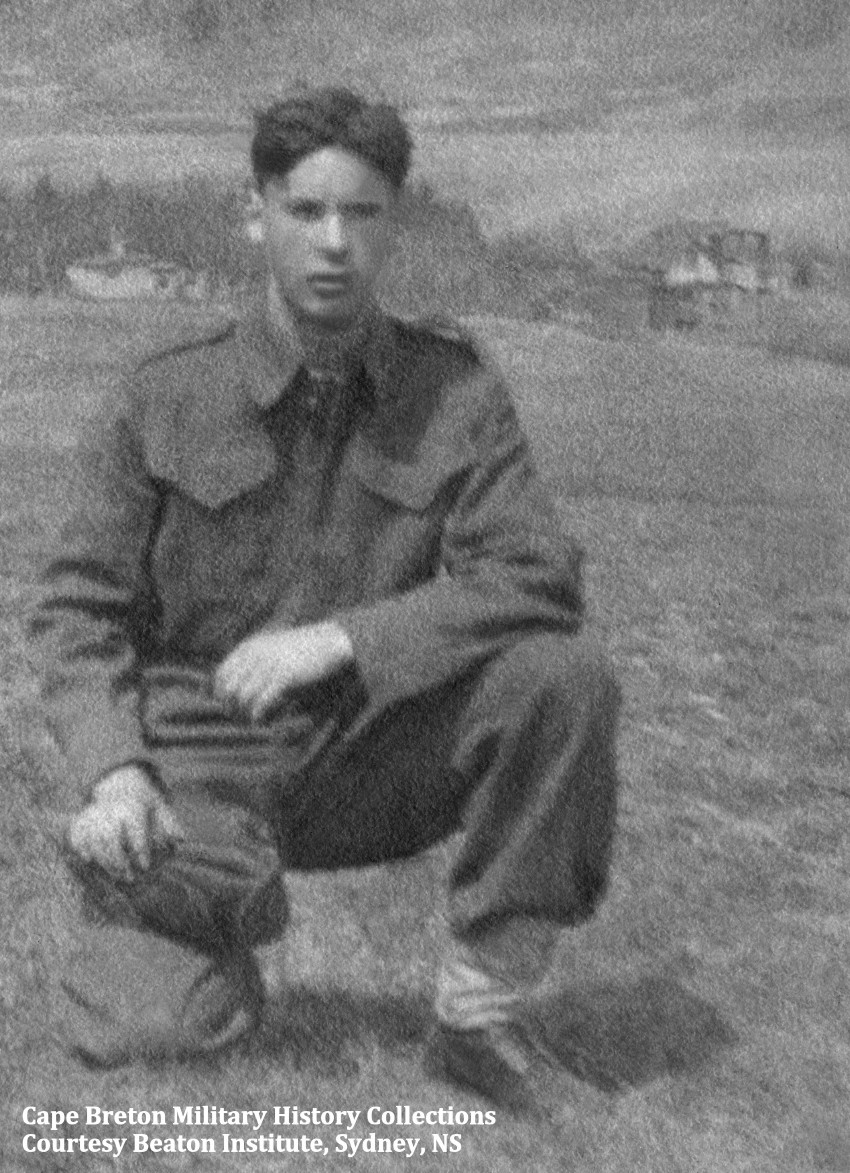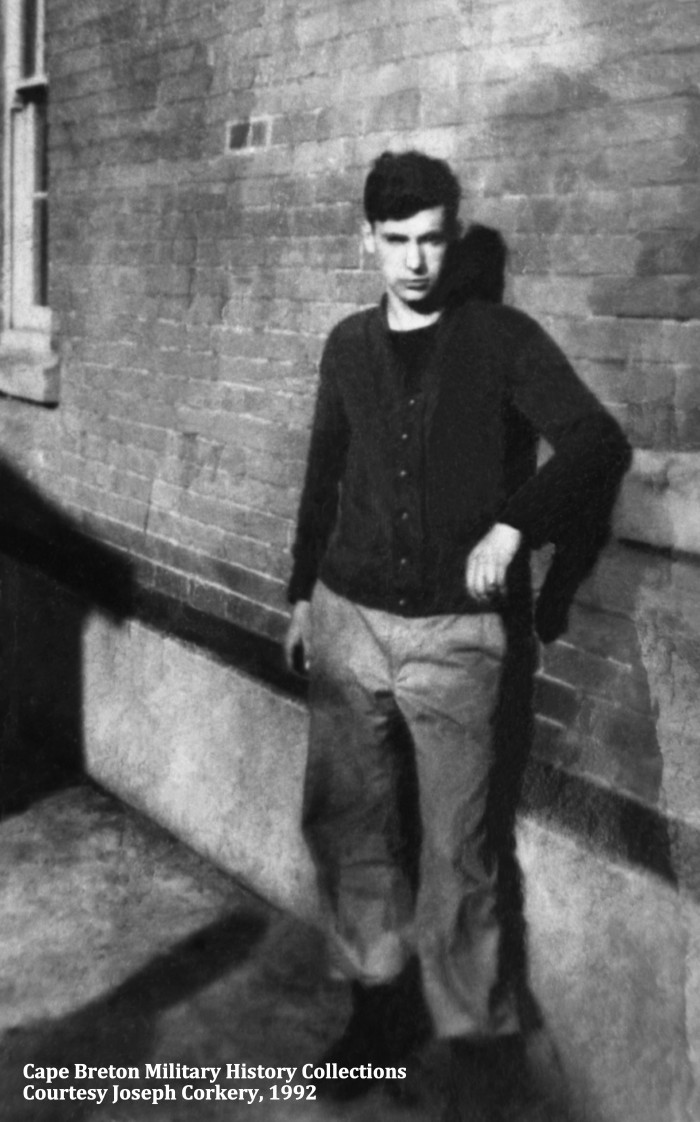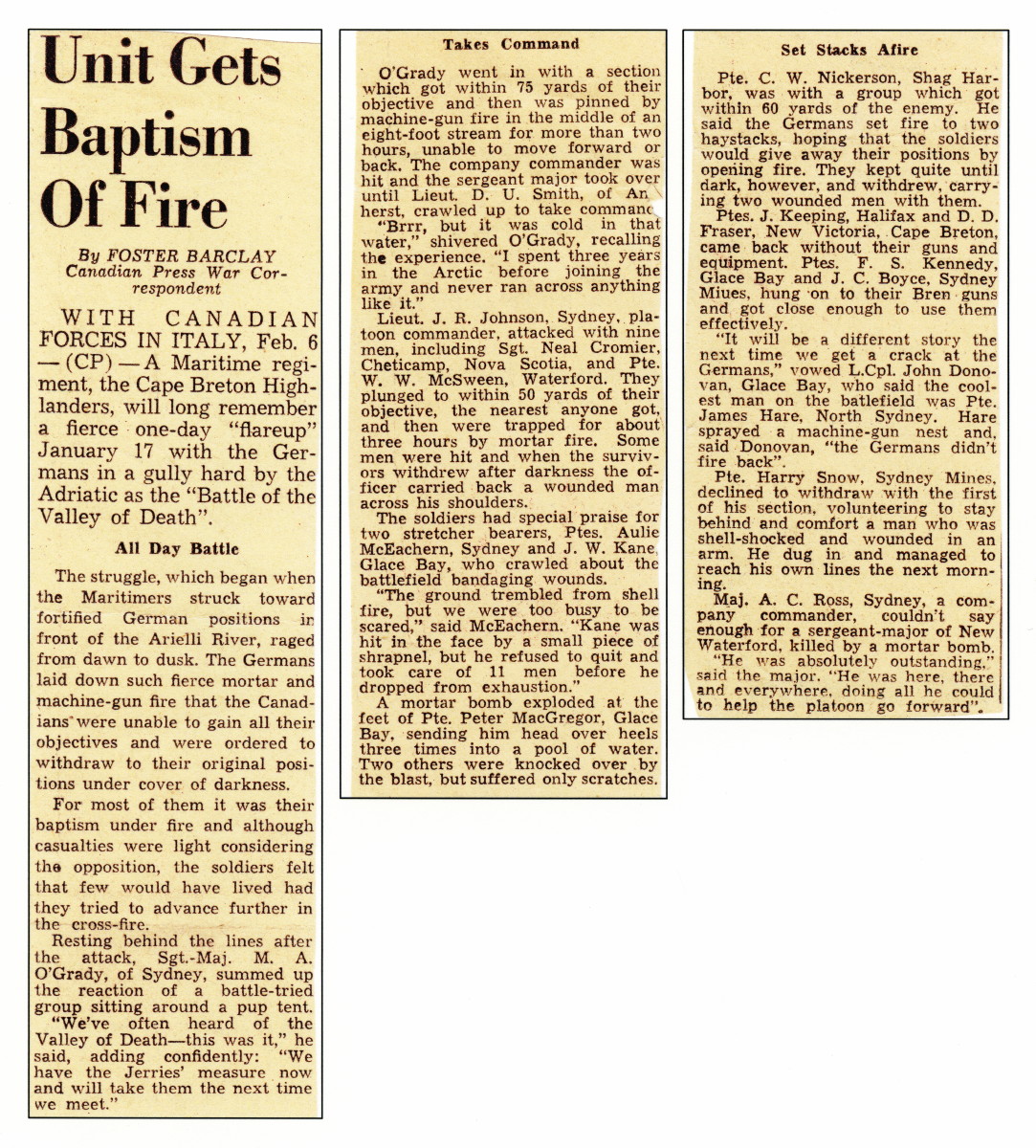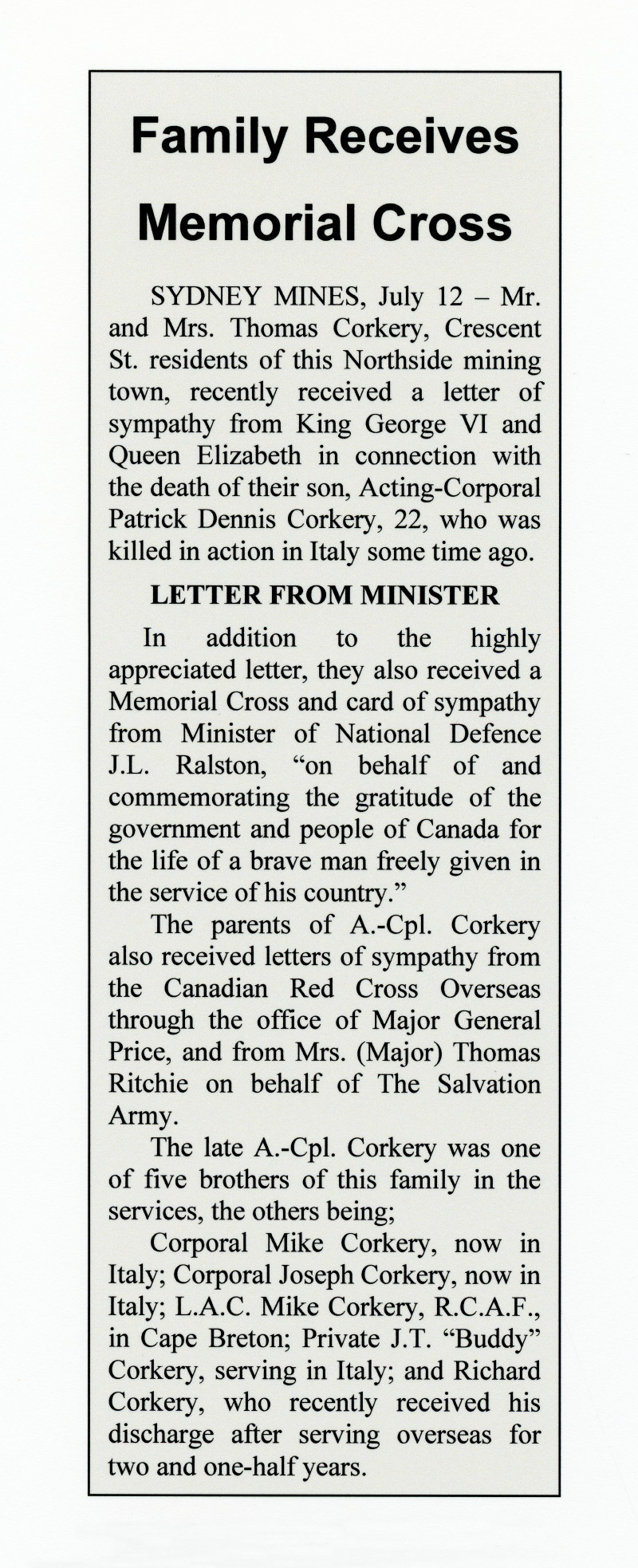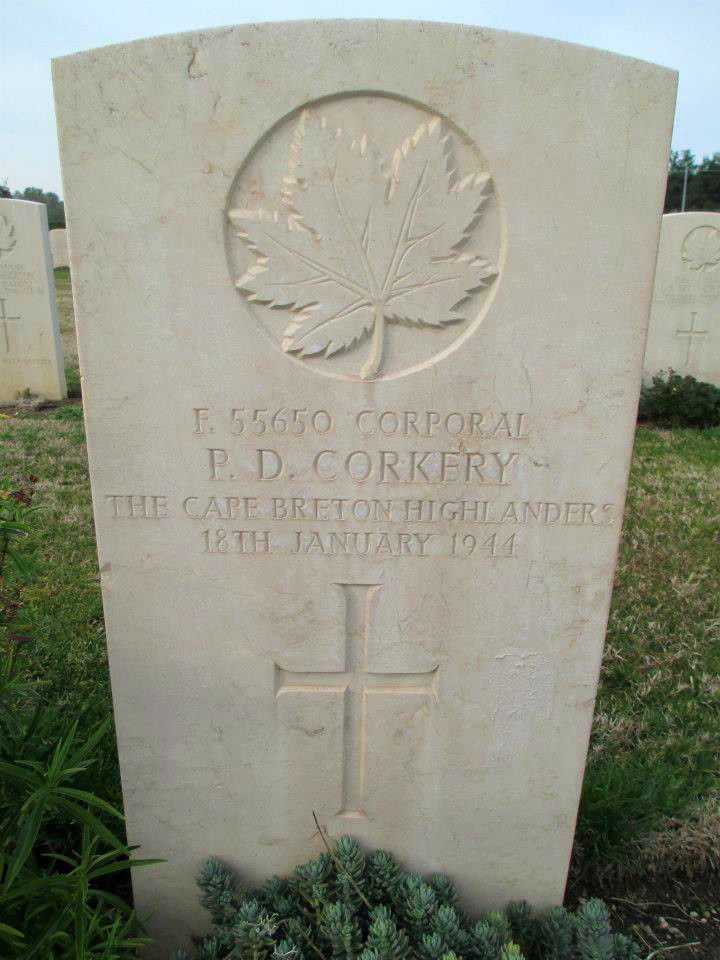Cpl. Patrick Duncan Corkery
Service Number F55650
"C" Company
Cape Breton Highlanders
Died of Wounds January 18, 1944
Patrick Duncan Corkery was born in Sydney Mines, NS, on September 9, 1922, the son of Mary Ellen (MacDougall) Corkery, from Codroy Valley, Newfoundland, and John Thomas Corkery from Sydney Mines. He grew up on Crescent Street in Sydney Mines with his six brothers and attended Notre Dame School. He also had a sister who died in infancy. Patrick enjoyed playing the fiddle in his spare time.
On August 12, 1940, Patrick enlisted as a private in the active forces, Cape Breton Highlanders. At that time the battalion was recruiting, training and providing guards for various installations in the Sydney/Glace Bay area. In January, 1941, the battalion relocated to Saint John, NB, for several months, where they provided coastal defence duties before spending the summer in Ontario training at Camp Borden and Connaught Ranges. At the end of September, 1941, they transferred to Camp Debert, near Truro, NS, before sailing from Halifax to England in November.
Patrick spent almost two years with the Cape Breton Highlanders training in the U.K. As well as individual and small unit training, they also took part in large scale exercises where they learned to work alongside and coordinate with other Canadian units. On September 1, 1943, Patrick was promoted to acting lance corporal and the following month he became acting corporal.
In October/November, 1943, the Cape Breton Highlanders sailed for Italy where they disembarked at the recently liberated port of Naples on November 10th. They were part of the 11th Canadian Infantry Brigade, 5th Canadian Armoured Division.
On January 17, 1944, the Cape Breton Highlanders took part in a larger Canadian attack to capture high ground east of the Arielli River near Ortona, on the Adriatic Sector of the Italian Front. It was the battalion’s first major action and it was carried out in daylight against veteran German paratroopers entrenched in well prepared defensive positions. To add to their difficulties, their sister battalion in the brigade, the Perth Regiment, had failed to take their objective on the left in an early morning attack, allowing the Germans to direct their full attention on the Cape Breton Highlanders’ attack.
“D” Company led the assault across the valley of a stream called the Riccio, with their objective being a piece of high ground near two roads on the far side of the Riccio. Patrick was in “C” Company which followed “D” Company’s attack ten minutes later. Although one platoon managed to make it across the stream, many of the remaining men were pinned down in the water due to the intense machine gun and mortar fire. Promised smoke protection was ineffective. It was during this fighting that Patrick was hit by machine gun fire and received numerous gunshot wounds. Unable to advance any further under the intense machine gun and mortar fire, and with mounting casualties, the survivors were ordered to pull back to their original positions after dark.
Severely wounded, Patrick was taken to a field hospital, but died the following day on the way to a rear hospital. Patrick’s brother, Joseph Corkery, also served in the Cape Breton Highlanders, and was a member of Support Company. He was able to see Patrick before he was sent to a rear hospital. His last words to Joseph were, “Watch yourself.” Father A.D. MacDonald, the padre of the battalion, was with Patrick when he succumbed to his wounds.
Thirteen Cape Breton Highlanders were killed in this action with many more wounded. To the survivors, the battlefield forever became known as “The Valley of Death”.
At the time of Patrick’s death, three of his brothers were actively serving in the Canadian Armed Forces. Michael was in the Royal Canadian Air Force. Buddy was in the Edmonton Regiment in Italy, and Joseph was with Patrick in the Cape Breton Highlanders. Another brother, Richard, had just received his discharge after serving two and a half years in the army. He had also been in the Cape Breton Highlanders.
Patrick Corkery was laid to rest in Moro River Canadian War Cemetery, near Ortona, Italy. He was 21 years old.
References:
- Library Archives Canada website for Second World War Service Files - War Dead 1939-1947. To access the page pertaining to Patrick Duncan Corkery, click HERE.
- Canadian Virtual War Memorial website. To accesss the page pertaining to Patrick Duncan Corkery, click HERE.
- Find a Grave website for Moro River Canadian War Cemetery. To accesss the page pertaining to Patrick Duncan Corkery, click HERE.
- The Beaton Institute's online digital archives for the Cape Breton Highlanders. To access the page pertaining to Patrick Duncan Corkery, click HERE.
- War Diary - Cape Breton Highlanders.
- Morrison, Alex and Slaney, Ted. The Breed of Manly Men – The History of the Cape Breton Highlanders. Sydney: City Printers Limited, 2002.
- Family information provided by Joseph Corkery (Patrick Corkery's brother) during an interview in 1992.
The Collection:
Below is a collection of photos and newspaper clippings pertaining to Patrick Corkery. They are frm various sources including his brother Joseph Corkery in 1992.
Click or tap on the images below for high resolution, expandable images. Use your back button to return to this page.
Patrick Duncan Corkery
Cape Breton Highlanders
Circa 1941-1943
The location is not known.
Photographer: Unknown
Ref. Number: 24-3 (1-1-1.2)
Image Information: Received as digital file
Source: Beaton Institute, Sydney, NS - Accession No. MG 20.5-E-1-4-1
Patrick Duncan Corkery
Cape Breton Highlanders
Undated
The location and date are not known. He appears to be dressed in civilian clothes.
Photographer: Unknown
Ref. Number: CBHHR-CorkeryPD-2.2
Image Information: Scan of a copy negative
Source: Robert Maclellan Collection (permission to copy original photo courtesy Joseph Corkery, 1992)
Newspaper Clipping Article
Unidentified Newspaper
Dated February 6, 1944
This section contains one newspaper clipping dispatch from an unidentified newspaper. The article is dated February 6, 1944, and was written by Canadian press war correspondent Foster Barclay. The article pertains to the Cape Breton Highlanders' first major battle of the war, an ill-fated assault across the valley of a stream called the Riccio, in Italy, on January 17, 1944. The battlefield later became known as "The Valley of Death". Many men are named in the article.
Ref. Number: 0-5 (1-4-1-3.2)
Writer: Foster Barclay (Canadian Press War Correspondent)
Image Information: Scan of original newspaper clipping
Source: Robert MacLellan Collection
"Family Receives Memorial Cross"
Transcribed Newspaper Clipping
Unidentified Newspaper
July, 1944
The newspaper clipping is an article pertaining to Patrick Corkery's death overseas and his family receiving a memorial cross and sympathy documents from the Canadian government. Unfortunately the article has Patrick Corkery's middle name listed as Dennis when it should be Duncan.
Ref. Number: CBHHR-CorkeryPD-3.3
Image Information: Scan of transcribed newspaper clipping
Source: Photocopy of newspaper clipping courtesy Robert MacLellan Collection
